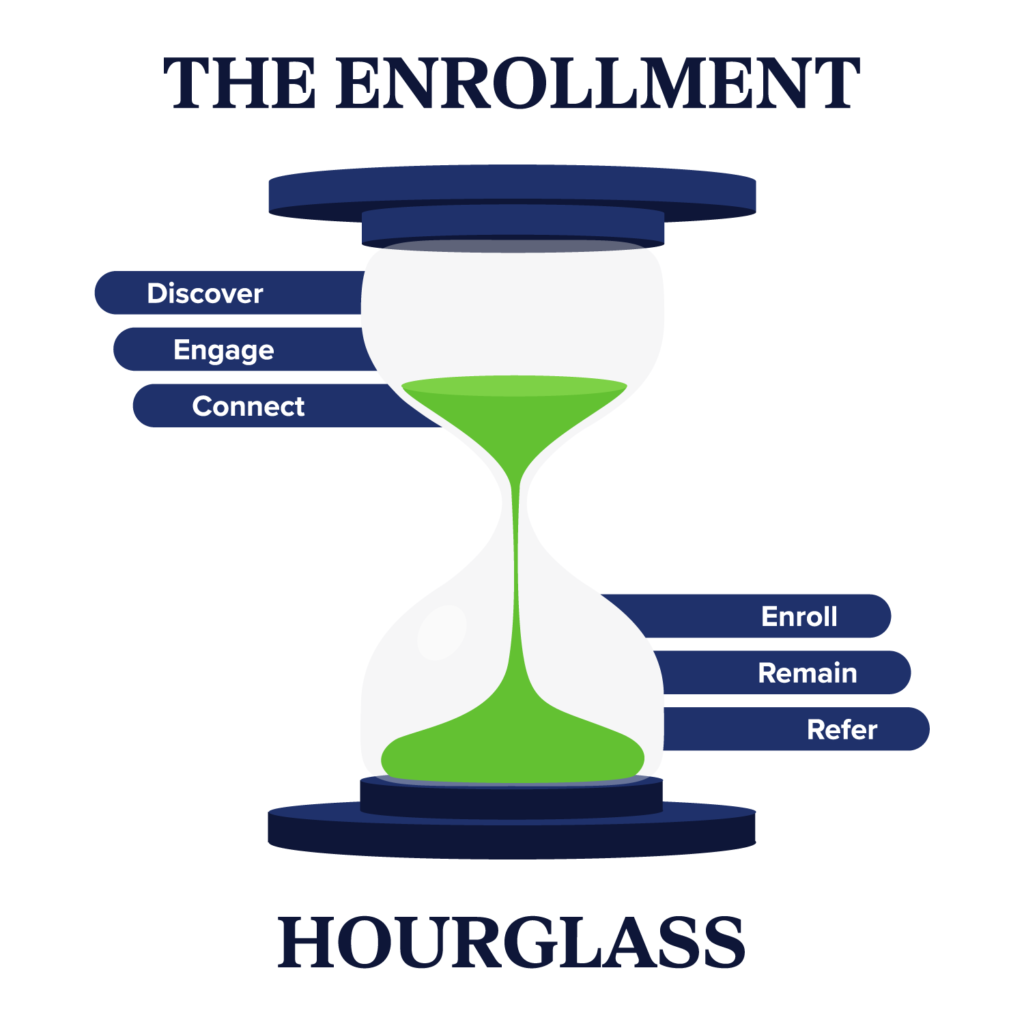This is Part Two of our series on creating a Christian school marketing plan.
What is the Enrollment Hourglass?
In this article, we’ll offer a high-level overview of the journey families take as they consider enrolling in your school. By understanding the Enrollment Hourglass framework, you’ll be able to think and act strategically to design a family-centered experience. Ultimately, this approach will help you put families first, creating stronger connections and leading to increased enrollment as a result.

Discover: Attracting Families to Your Christian School
Parents generally discover a school in one of two ways: through Intent or Interruption. Intent-driven discovery happens when families actively search for a school online or ask friends, family, or coworkers about their children’s school and experience.
Interruption, on the other hand, encompasses a broader range of encounters. These can include seeing your school’s road signs, noticing a friend liked or shared your social media posts, encountering your ads online or offline without prior searches, overhearing a coworker praise or criticize your school, receiving a church bulletin insert about your school, and many other unplanned interactions.
You should use both Intent and Interruption methods to maximize your reach and attract families to your Christian school.
Engage: Building Relationships with Prospective Families
Once the Discovery phase occurs, families have the choice to either lean in or head out. Your task is to create captivating marketing that engages them and encourages further exploration. Engagement is not a one-time event; parents may interact with your school’s website, marketing materials, or other parents multiple times before you even know they exist.
This stage is critical as it represents the first and easiest opportunity for prospective families to lose interest. If they disengage at this point, you may lose them altogether. Aside from retargeting ads, you have limited control over when or if they will re-engage. Therefore, it’s crucial to make a lasting impression and foster strong connections during this phase to keep prospective families interested in your Christian school.
Connect: Getting Prospective Families Off the Internet and Onto Your Campus
The goal in this phase is to swiftly and smoothly transition prospective families from “anonymous” to “known.” Once a family connects, you have the opportunity to follow up, build trust, deepen their understanding of your school, and provide a personalized experience.
Connection occurs when families share their contact information, so it’s essential to offer numerous opportunities for this exchange. Lead magnets (such as downloadable resources or interactive content in exchange for contact information), online forms, and easily accessible staff contact information are all avenues through which connection can happen.
Enroll: Converting Prospective Families into Enrolled Students
Enrollment is not just a single event but an ongoing process that begins as soon as a family connects with your school. The Enroll phase encompasses every interaction families have with your school, from their first contact until they sign on the dotted line. This includes emails, school tours, meetings, and the whole application process.
This phase offers a significant opportunity for Christian schools. A poor admissions experience or lackluster follow-up efforts will result in a leaky enrollment pipeline. To prevent this, it’s crucial that every aspect of the “Enroll” phase is meticulously planned and executed.
Remain: Retaining Current Families in your Christian School
The “Remain” phase of the Enrollment Hourglass focuses on retaining current families within your school community. You’ve likely heard this before, but here’s a reminder: it costs more — 4-6 times more — to acquire a new customer than to keep an existing one (Marketing Metrics).
Retention isn’t something you start thinking about during the re-enrollment season. It isn’t a last-ditch effort to save a disgruntled family. Retention is a year-round conscious and concerted marketing effort that starts even before a family enrolls in your school. Remember the “Engage” phase? That’s when retention really begins. During these pre-enrollment days, expectations are set, and the school’s mission is presented to prospective families. Few things will kill retention like a family enrolling because they expected one thing, then discovering your school really isn’t positioned to deliver on that expectation.
Successful retention strategies blend storytelling, systems, and shepherding. We’ll dive into those ideas in a later post. By focusing on keeping current families happy and engaged, you’re not only promoting a sense of belonging but also fostering a strong foundation for your Christian school’s long-term success.
Refer: Transforming Current Families into Brand Ambassadors
The final phase of the Enrollment Hourglass focuses on transforming current families into enthusiastic brand ambassadors. Word of mouth (WOM) is a potent marketing tool for Christian schools, as families who genuinely love your school can become your most effective promoters. However, many schools overlook the potential of WOM and don’t intentionally invest in maximizing its impact.
In his book “Word of Mouth Marketing: How Smart Companies Get People Talking,” Andy Sernovitz outlines the five Ts every organization (including schools) should address to build an effective WOM marketing plan. To keep it brief, here are the five Ts:
- Talkers: Identify people who will talk about your school
- Topics: Provide reasons for people to discuss your school
- Tools: Offer resources that help the message spread faster and farther
- Taking Part: Participate in the conversation
- Tracking: Monitor and understand what people are saying
By investing in your current families and empowering them to become confident ambassadors, you can establish a robust network of support. This not only attracts more right-fit families to your school but also enhances your school’s reputation and fosters a strong sense of community.
In the coming weeks, we’ll dive into each phase more deeply.

